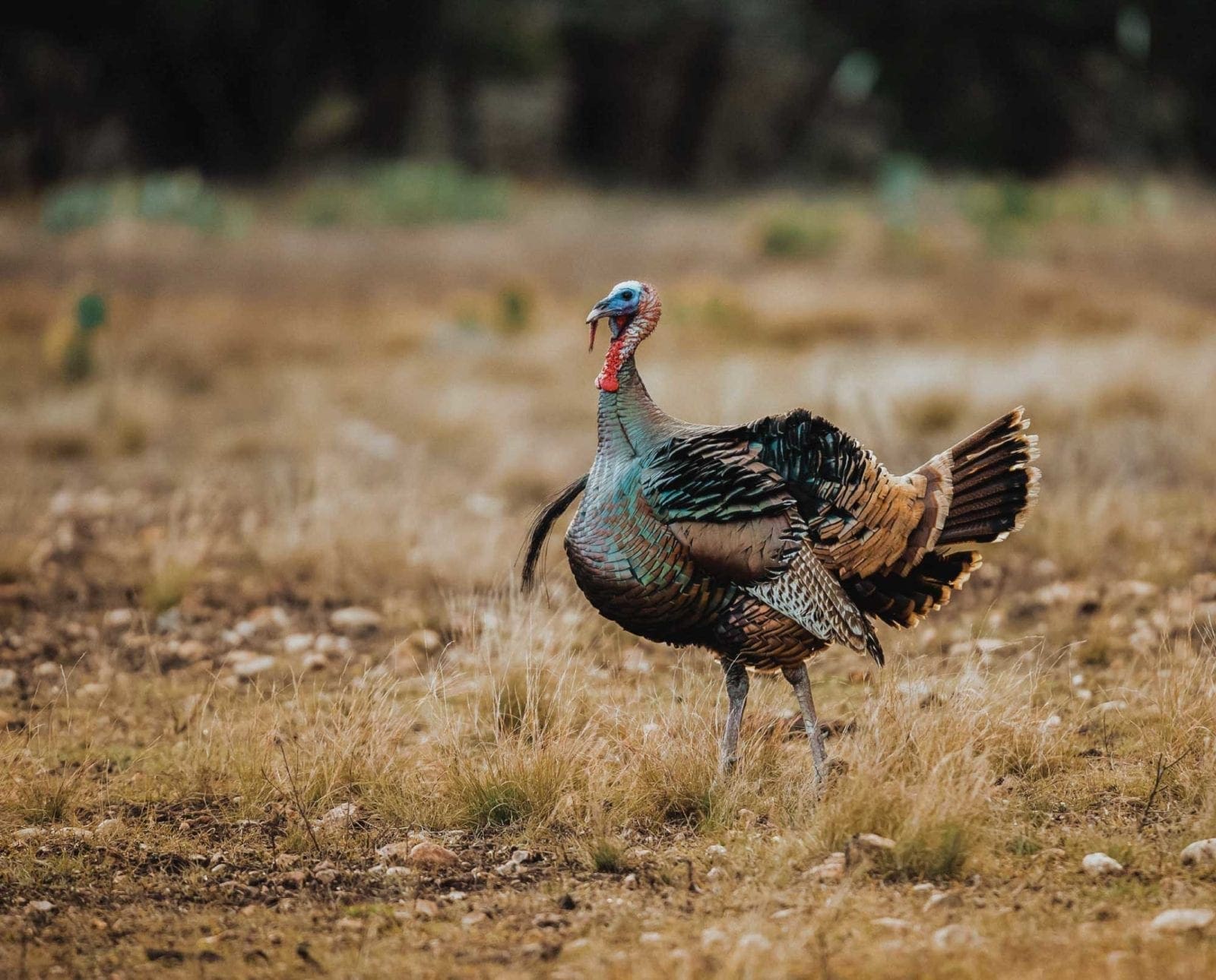Home » Turkey Hunting » Rio Grande Wild Turkey (Meleagris gallopavo intermedia)
Rio Grande Wild Turkey (Meleagris gallopavo intermedia)
- Can be hunted in 14 States
- Spring hunting seasons range from March 13 to May 31st, 2021
- Males weigh in at only about 20 pounds
- Females weigh between 8 to 12 pounds
- Moderately loud gobble compared to the other subspecies
- Males tend to have long spurs around 2 inches
- Have a bronze or copper iridescent sheen to male feathers
- One of the most widespread subspecies besides the Eastern wild turkey

Ryan Lisson is a biologist and regular content contributor to…
The Rio Grande wild turkey is more than just a Texas bird
The Rio Grande subspecies of wild turkey (Meleagris gallopavo intermedia) is best known for the arid regions of the south-central United States. But it has also been introduced along the entire West Coast and to most of the western half of the country. Here is what you need to know about the Rio Grande wild turkey if you want to check it off your list.
Description and life history of the Rio Grande wild turkey
The Rio Grande wild turkey is very similar to the Eastern wild turkey. Though males typically outweigh females, Rio Grande males weigh in at only about 20 pounds while females weigh between 8 to 12 pounds (NWTF 2018a). Male turkey feathers are very similar to Eastern wild turkeys but have a bronze or copper iridescent sheen. Hens have dull feathers similar to the Easterns. The wing barring is black and white like the Eastern wild turkey, but its tail is cream to buff-colored with a dark band across the end. Rio Grande gobblers have moderate length beards which start to appear at about 6 to 7 months of age (NWTF 2018a; Texas A&M 2018). Like the Eastern wild turkey, tom heads will usually be red and blue throughout the year, but they will also contain brighter shades during the breeding season. Hens have consistently bluish-gray heads with more feathers than toms. Though females occasionally develop short, blunt spurs, male spurs are pointed and measure about 2 inches as they mature. The Rio Grande subspecies also tends to have slightly longer legs than other subspecies.
Rio Grande toms have a moderately loud gobble compared to the other subspecies (NWTF 2018a). After breeding, hens seek out a sheltered area with enough cover to hide in (e.g., brush piles, large clumps of grass) to scratch a nest on the ground (Cornell 2018; NatureServe 2018). Normally, 10 to 11 cream-colored eggs are laid in as many days and the hen incubates them for about 28 days (Texas A&M 2018).
Once hatched, the brood stays fairly close to one another, feeding heavily throughout most of the daylight hours on protein-rich invertebrates (e.g., grasshoppers, spiders and beetles). Their adult diet consists of whatever they can opportunistically forage, including grasses, seeds, buds, grains, fruits, hard mast, insects, and even amphibians or small reptiles (Texas A&M 2018; NatureServe 2018).
Though Rio Grande turkeys are active during the day, they roost at night in open hardwood trees with many horizontal limbs. This keeps them relatively safe from most ground predators, though younger birds may still fall prey to large raptors. Rio Grande turkeys prefer to roost over an open understory, including over open water (Texas A&M 2018). When the sun rises, they spend the day foraging on the ground.
Range and habitat of the Rio Grande wild turkey
The Rio Grande wild turkey primarily occupies the south-central states (i.e., Texas, Oklahoma, Kansas, Colorado, and New Mexico) and northern Mexico. They have also been successfully introduced to California, Oregon, Washington and several other states as listed below. Rio Grande turkeys require a large area to roam and some individuals may travel within a 2,400 to 6,600 acre range each year (Texas A&M 2018).
Rio Grande turkeys, like most other turkey subspecies, require a combination of different habitats throughout their lifetime. In New Mexico, they seem to prefer river valleys and riparian areas with brush and mature roost trees in close proximity (NMGF 2018). In Texas, they seek out areas with lots of edge habitat, which helps them to escape from predators and the hot summer sun (Texas A&M 2018). Mature hardwood trees including “live oak, hackberry, pecan, elm, and cottonwood” are required for roosting and are often located along riparian areas (Texas A&M 2018). Rio Grande wild turkeys prefer roost trees that have open spaces (e.g., meadows, hayfields, trails, etc.) within 100 yards. These provide a space to fly up into the roost and to land again in the morning. Mature oak, pecan, beech and walnut forests also provide hard mast in the fall.
Nesting cover includes shrublands, dense field edges and tall grass areas where hens can hide from most ground predators. Once poults hatch, the hen and brood require bugging habitat in the form of short crop fields, hayfields and meadows. Turkeys also need areas where they can dust themselves, such as open soil or trails. Dust baths help clean their feathers and can dislodge parasites, which makes the ritual an important part of everyday life (NWTF 2018b).
Conservation issues with the Rio Grande wild turkey
As with all of the turkey subspecies, the biggest source of mortality for individuals is during the nesting season. Since hens nest on the ground, a large number of different predators consume the unhatched eggs, including foxes, raccoons, skunks, snakes, and feral hogs (Texas A&M 2018). After hatching, the poults are susceptible to many of these predators, as well as raptors such as hawks and owls. Heavy spring rains and flash flooding can also severely affect nesting success. Habitat destruction due to land use changes, such as ranching or development, can also hinder the species. As a result, recruitment of poults into the adult population is fairly low. Nevertheless, the Rio Grande subspecies population appears to be holding steady throughout its range and is one of the most widespread subspecies besides the Eastern wild turkey.
Hunting opportunities for the Rio Grande wild turkey
Texas, Oklahoma, and Kansas offer the best habitat and historic range for the Rio Grande turkey. However, as mentioned, they have been introduced to other geographies and can be found and hunted in many other states.
The first step is to find the right habitat, such as riparian areas with tall roost trees alongside and open fields or areas where they can forage during the day. Once you find potential roost trees with turkey sign during the day or hear toms gobbling in the early morning, you’ll want to make sure you don’t spook them on the roost. Set up a good distance away and start calling them in to your position. The Rio Grande subspecies does not seem to be bothered by loud calling. In fact, many hunters call very aggressively to gobblers with great results. If you like calling turkeys in, hunting the Rio Grande subspecies may be your new favorite thing.
If you are pursuing a turkey slam of almost any sort, you’ll need to harvest a Rio Grande turkey at some point. Here are the states where you can pursue them during the regular shotgun season, as well as their seasons and limits. As always, thoroughly review the hunting regulations before you make any plans.
Spring 2021 Rio Grande Turkey seasons
(Last updated January 26th, 2021)
| State | Method | Season | Season Limit |
| Arizona** | General | Apr 23-29, & May 7-20, 2021 | 1 bearded |
| Cont. | Apr 30 – May 20, 2021 | ||
| California | General | March 27-May 2, 2021 | 1/3 bearded |
| Archery | May 3-16, 2021 | ||
| Youth | March 20-21 & May 3-16, 2021 | ||
| Colorado | General | April 10 – May 31, 2021 | 2 bearded |
| Archery | April 10–May 31, 2021* | ||
| Idaho | General | April 15 – May 25, 2021* | 2 bearded |
| Youth | April 8-14 & April 8 – May 25, 2021* | ||
| Kansas | General | April 14 – May 31, 2021 | 1 bearded per permit |
| Archery | April 5-13, 2021 | ||
| Youth/Disabled | April 1-13, 2021 | ||
| Nebraska | General | April 18 – May 31, 2021 | 1 bearded per permit |
| Archery | March 25 – May 31, 2021 | ||
| Youth | April 11 – May 31, 2021 | ||
| Nevada** | General | March 20 – May 2, 2021* | Quota Varies by Counties |
| Youth | March 27 – May 2, 2021* | ||
| New Mexico** | General | Apr. 15-May 10, 2021* | 1 to 2 bearded varies by unit |
| Youth (Unit 30) | Apr. 25-26 & May 2-3, 2021 | ||
| Oklahoma | General | April 6 – May 6 & April 19 – May 6, 2021 (SE)* | 3 male turkeys |
| Youth | April 3-4 & April 17, 2021 (SE)* | ||
| Oregon** | General | April 15 – May 31, 2021 | 3 bearded |
| Youth | April 10 – 11, 2021 | ||
| South Dakota** | General | Apr 10 – May 31, 2021* | 1 bearded |
| Archery | Apr 3 – May 31, 2021 | ||
| Texas | General (North) | April 3 – May 16, 2021 | Varies by county |
| General (South) | Mar. 20 – May 2, 2021 | ||
| One-turkey counties | Apr. 1-30, 2021 | ||
| Youth (North) | Mar. 27-28 & May 22-23 | ||
| Youth (South) | Mar. 13-14 & May 8-9, 2021 | ||
| Utah** | General | May 3–31, 2021 | 1 bearded |
| Youth | April 30–May 2, 2021 | ||
| Limited-entry hunt | April 10–April 29, 2021 | ||
| CWMU hunt | April 10–May 31, 2021 | ||
| Washington** | General | Apr. 15-May 31, 2021 | 3 bearded based on counties |
| Youth | Apr. 3-4, 2021 | ||
| Wyoming | General | April 1-May 31, 2021* | 1 bearded |
* Varies by unit click on state for details
** Some or all permits maybe subject to drawing
Ryan Lisson is a biologist and regular content contributor to several outdoor manufacturers, hunting shows, publications, and blogs. He is an avid small game, turkey, and whitetail hunter from northern Minnesota and loves managing habitat almost as much as hunting. Ryan is also passionate about helping other adults experience the outdoors for their first time, which spurred him to launch Zero to Hunt, a website devoted to mentoring new hunters.



